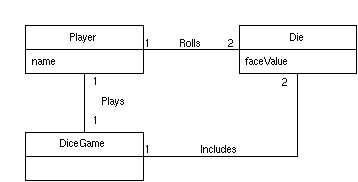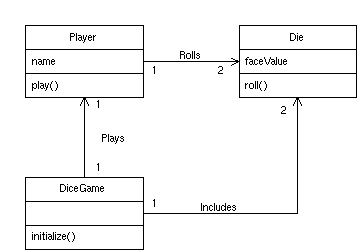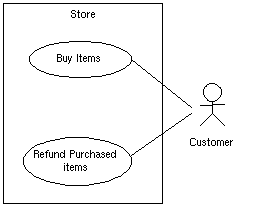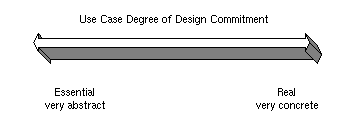the road ahead
|
Classes
|
|
Methods
|
|

|

|

|
|
Design Class
Diagrams
|

|
Interaction
(Collaboration)
Diagrams
|
|

|

|

|
|
Conceptual
Model
|
|
Contracts
|
|
|
|

|
|
|
|
System
Sequence
Diagrams
|
|
|
|

|
|
|
|
Expanded
Use Cases
|
Example
dice
game 
throw
two dice,
if total = 7 you win, else you lose
use case
description of a process in the domain
|
Use case
|
Play a game
|
|
Actors
|
Player
|
|
Description
|
Player picks up and rolls the dice.
The player wins if the total is 7.
|
Conceptual model
Concepts - entities
recognised in the external world
player
die
dice game

collaboration diagrams
show flow of messages between objects

class diagrams
software
components, not external world concepts - but may model concepts

Reading
- Applying UML & Patterns
part 1, browse
chapters 4 and 5
- Object Oriented
software Construction
version 1, chapters 1-4 or
version 2, chapters 1-5
public class Die {
protected int faceValue;
public int getFaceValue() {
return faceValue();
}
public void roll() {
faceValue = (int) (Math.random() * 5 + 1)
}
}
public class Player {
protected String name;
public Player(String name) {
this.name = name;
}
public void play(Die die1, Die die2) {
die1.roll();
die2.roll();
}
public String getName() {
return name;
}
}
public class DiceGame {
protected Die die1, die2;
protected Player player;
public static void main(String[] argv) {
game = new DiceGame();
game.play();
if (game.isWon()) {
System.out.println("Won");
} else {
System.out.printl("Lost");
}
}
public DiceGame(String name) {
player = new Player(name);
die1 = new Die();
die2 = new Die();
}
public void play() {
player.play(die1, die2);
}
public boolean isWon() {
return (die1.getFaceValue() == die2.getFaceValue());
}
}
Point of Sale Terminal
use cases
(chapter
6)
Narrative
describing a sequence of events of an actor who uses a system to
complete a process.
Not requirements,
but illustrate and imply requirements.
Actors are external
to the system
Use cases may be
- high level or expanded
-
essential or real
High level use case
concise description
of process
|
Use case
|
Buy Items
|
|
Actors
|
Customer, Cashier
|
|
Type
|
primary
|
|
Description
|
Customer arrives at checkout with
items to purchase. Cashier records purchase items and collects
payment. On completion, Customer leaves with items.
|
Expanded use case
|
Use case
|
Buy
Items with Cash
|
|
Actors
|
Customer (initiator), Cashier
|
|
Purpose
|
Capture a sale and its cash payment
|
|
Overview
|
Customer arrives at checkout with
items to purchase. Cashier records purchase items and collects
payment. On completion, Customer leaves with items.
|
|
Type
|
primary
|
|
Cross References
|
|
Typical course
of events
|
Actor Action
|
System Response
|
|
Use
case begins when a Customer arrives at POST checkout with items
to buy.
|
|
|
Cashier
records identifier of each item.
If several of same item,
Cashier can enter quantity.
|
Determines
item price and adds item info to transaction.
Description and price of
current item presented.
|
|
On
completion of item entry, Cashier tells POST that item entry is
complete.
|
Calculates
and presents the sale total.
|
|
Cashier
tells Customer the total.
|
|
|
Customer
gives Cashier at least enough cash.
|
|
|
Cashier
records the cash received amount.
|
Shows
change to be given to customer.
Generates a receipt.
|
|
Cashier
deposits cash received and extracts balance.
Cashier gives change and
receipt to Customer.
|
Logs
the completed sale.
|
|
Customer
leaves with items purchased.
|
|
types of use case
- Primary
- Major common processes
(buy items)
-
Secondary
- Minor or rare processes
(stock new item)
- Optional
- May not be implemented.
(product recall)
-
-
use case diagrams

System boundaries
Use case interaction with system
Must know system boundary
If boundary was
store:

use cases
Actors are
external to the system
Use case is
about a process (buy items), not a step (write receipt)
Identifying
use cases
-
Actor based
identify
actors
for each
actor, identify processes
-
Event based
identify
external events
relate events
to actors
Alternate opinion on use cases
(Meyer, OOSC pp 738-740)
Use cases not
appropriate for analysis in general, and finding classes in
particular.
They focus on
process rather than data abstraction.
They are
appropriate as a validation tool - to inspect a proposed analysis
model.
essential use case
Use cases expressed
in a way that does not imply an implementation.
examples
|
Essential
|
Real
|
|
go
to the shop
|
ride
your bike to the shop
|
|
|
hang
the clothes on the line
|
|
wash
the dishes
|
|
|
|
send
a letter to the customer saying that the goods have arrived
|

Essential use case
|
Actor Action
|
System Response
|
|
The
customer identifies themselves.
|
Presents
options.
|
Real use case
|
Actor Action
|
System Response
|
|
The
customer inserts their card.
|
Prompts
for PIN.
|
|
Enters
PIN on keypad.
|
Displays
options menu.
|
development cycles
(chapter
7)
The first version
of the software may not implement everything.
whole system
is too complex
some parts
less important
may want to
get something working quickly
So, several
versions, each with its own development cycle.
Requirements -> OOA -> OOD -> Implementation
|
OO paradigm supports
incremental development
|
What goes in the first version?
-
Rank use cases
-
First version implements higher ranking use cases
How to rank use cases
rank use cases
higher if they
have
significant impact on architecture
(add many classes or extra
layer such as persistence)
give
significant insight into design with little effort
require risky,
time-critical or complex functions
involve
significant research or new and risky technology
represent core
business
have impact on
"bottom line"
(more revenue, reduce costs)
Ranking POST use cases
|
Rank
|
Use Case
|
Justification
|
|
High
|
Buy
Items
|
Scores
on all except d)
|
|
Medium
|
Add
new users
Log
in
Refund
items
|
Affects
security domain
Affects
security domain
Core
business, affects accounting
|
|
Low
|
Cash
out
Start
up
Shut
down
|
Minimal
effect on architecture
Depends
on other use cases
Minimal
effect on architecture
|
Start up use case
Need at least a simplified version to
get going.
eg create an empty store
Start up developed
incrementally to satisfy other use cases as they are included.
Where we are
Requirements -> OOA -> OOD -> Implementation
![]()
![]()
![]()
![]()
![]()







